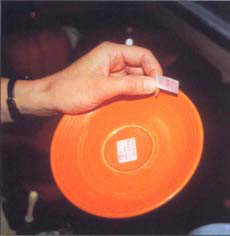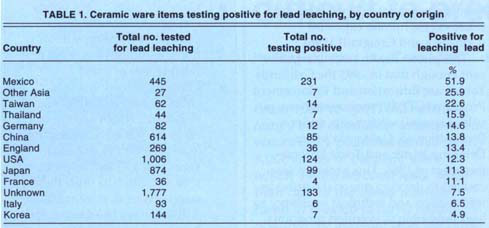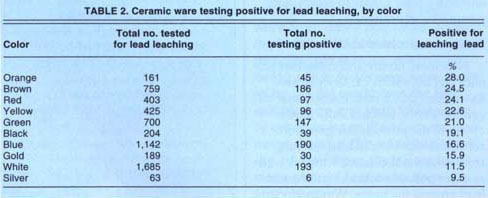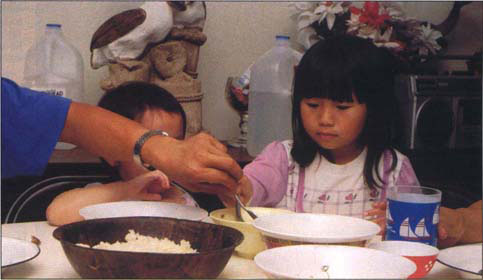All Issues
Lead leaching in ceramics difficult to predict
Publication Information
California Agriculture 53(5):20-23. https://doi.org/10.3733/ca.v053n05p20
Published September 01, 1999
PDF | Citation | Permissions
Abstract
From 1993 to 1997, UC nutrition, family and consumer sciences advisors in 21 counties tested nearly 6,000 items of ceramic ware, of which 14.2% leached lead. More than half of the items manufactured in Mexico (51.9%) tested positive for leached lead with the UC Quick Lead Test. Ceramic ware from other countries, including the United States, also tested positive. No factors, other than being made in Mexico, were found to be useful predictors for lead leaching on any individual piece of ceramic ware. Consumers concerned about the possible leaching of lead from their ceramic ware should test each item individually.
Full text
Lead toxicity is now recognized to be much more widespread than originally believed. In recent years, the “cut-off” blood lead level for defining lead “poisoning” was reduced from 15 μg/dl to 10 μg/dl, and thus more children are considered to be at greater risk of suffering adverse effects from lead exposure. Lead can be found throughout our environment, mostly as a result of Industrial Age (1800 to present) uses and practices. Sources of lead include soil, paint manufactured before 1978, water, leaded gasoline, and paints and glazes used in the production of ceramic ware. Certain hobbies that use lead, such as soldering stained glass, casting of fishing weights, shooting and reloading, and home remodeling, may also result in exposure.
The UC Quick Lead Test indicates by color change, from clear to pink, that lead has leached out of this saucer.
For most people, lead in paint and soil are the most common sources of exposure. In some cases, however, lead in tableware can lead to lead poisoning, also called plumbism. Even though the amount ingested after lead leaches into food is generally very low, researchers have found that plumbism can result from protracted use of ceramic ware leaching lead at high rates. (Lecos 1987; Blumenthal 1990; UPDATES 1990A). Avila et al. (1991) reported a significant correlation between the use of lead-glazed ceramics and elevated blood lead levels in Mexican women. They determined that 58% of the population's attributable risk of high blood lead levels was due to the use of lead-glazed ceramics to prepare food.
Health professionals are concerned that even very low levels of ingested lead can significantly affect people's health, particularly children under the age of 5 years (De la Burde and Choate 1972, 1977). Needleman et al.(1990) reported a strong correlation between lead body burden and deficits in language processing, attention, psychomotor performance and success in school. Bellinger et al. (1987) showed that blood lead levels as low as 0.72 to 0.97 micromoles per liter (μmol/L, or 15 to 20 micrograms per deciliter, μg/dL) could negatively affect cognitive function in children. Lead-induced anemia has also been reported in children with blood levels of 1.93 μmol/L (40μg/dL) (WHO 1977).
Children also absorb a greater percentage of ingested lead than adults do. A poor diet, especially one that contains little calcium and iron, can impact the body burden of lead by increasing its absorption from the gastrointestinal tract or decreasing its excretion. (Fullmer and Rosen 1990; Markowitz et al. 1990).
Lead has properties that make it ideal as a base for glazes and paints. Lead is used widely to enhance the vividness of colors and produce a smooth, glossy appearance (Lecos 1987). Firing pottery at the appropriate temperature for a sufficient amount of time ensures that lead is incorporated in the glaze, making it resistant to acid leaching. But any shortcomings in the technique used to prepare, apply or fire glazes may result in leaching of lead as glazes become worn or cracked due to use and repeated washings. Acidic foods such as fruit juices, tomato products, coffee, tea and wine have the potential to leach lead and cause excess human exposure (Gonzalez and Craigmill 1996).
This public health issue is significant enough that in 1993 the California Tableware Education and Enforcement Program (CTEEP) was created as a result of lawsuit settlements under Proposition 65, California's Safe Drinking Water and Toxic Enforcement Act of 1986. This program was created to develop materials, provide information and technical assistance to lead poisoning prevention programs, and administer grants to community groups for education.
State research/education effort
Nutrition, family and consumer science advisors with UC Cooperative Extension (UCCE) understood mat the general public was not sufficiently aware of the possible dangers from continual exposure to lead leaching from household ceramic ware, as well as other possible common sources of lead around the home. We developed a research/educational program targeting families with children younger than 6 years of age and at risk of lead exposure. Risks include living in homes built before 1978 or located near freeways, and adults living in the home who use lead at work or for a hobby.
How to avoid lead poisoning
The following tips will help to minimize the risk of lead exposure from ceramic ware:
-
Choose dishes with patterns around the rim, where they are less likely to come in contact with food and leach lead.
-
Choose coffee cups and mugs with patterns that won't come in contact with your mouth or beverage.
-
Do not use any items with corroded glaze, or that have a dusty or chalky residue on the surface after the piece has been washed.
-
Do not store acidic foods or liquids in questionable ceramic ware or leaded glass containers. The longer the storage, the more lead is leached out of the container.
-
Do not wash questionable pieces in the dishwasher with other dishes. The lead can transfer to the surface of the other pieces.
-
Use clear glass plates, bowls and mugs that have no painted or decal-type decorations on the surface; these are reliably free of lead.
-
Choose certified low-lead china that meets California standards, which are the strictest in the nation. Corning, for example, has offered assurances that 100% of its products sold in California meet these standards. Ask store manager if dishes have been tested for lead leaching.
-
If you choose stoneware dishes, look for those that are fairly heavy and that have a low shine instead of a bright gloss; these are normally coated with a material that does not contain lead. Unless they have painted or decal-type decorations on the surface, stoneware pieces are almost as lead-free as glass.
Twenty-one counties in California participated in UCCE's Lead Poisoning Awareness Program. Residents of these counties brought their ceramic ware to the program for testing. We presented information on the sources of lead found in and around the home, such as soil, water, paint, hobbies, employment, food, folk remedies, calcium supplements, ceramic ware and makeup. Discussion also centered around the hazards of lead to human health including the fetus, infants and children, symptoms, persons at risk, treatment, and nutrients which interact with lead (to promote the consumption of calcium and iron-rich foods). Ceramic ware was tested using the UC Quick Lead Test (UCQLT). Results were recorded and data was analyzed at UC Davis.
UC Quick Lead Test
The UCQLT – based on the Food and Drug Administration's Quick Color Test for lead in ceramic ware – was developed by Arthur L. Craigmill, UC Davis toxicologist; Scott Wetzlich, department of environmental toxicology, UC Davis; and Allison Beale, environmental toxicology and water advisor, Sacramento County. It is composed of two steps (Beale et al. 1991). The first step is the extraction of leachable lead using 0.5% citric acid by placing a few drops on the surface of each color and the glaze. This is allowed to sit for 2.0 minutes, followed by wiping with a filter paper to collect the liquid or by rubbing gently with a cotton swab for several seconds. Second, a drop of the indicator (0.1% rhodizonic acid to chelate lead) is placed on the swab or filter paper with the leachate. A change in color from yellow to redindicates the presence of lead.
The UCQLT indicates the presence of lead, not the specific amount. The intensity of the color change is compared to standard test strips, which contain low, medium and high concentrations of lead. Results were scored as 0 (no color change), 1 (light red), 2 (bright red) or 3 (dark red to purple).
Nutrition, family and consumer science advisors were trained on the protocol for using the UCQLT. Protocol and background packets were prepared for each county, in addition to test kits from the department of environmental toxicology at UC Davis. County advisors in turn trained health professionals, such as the county lead nurse, Head Start nurses, volunteer master food preservers, and public health workers. We conducted workshops at county Cooperative Extension offices, Head Start programs, Parent Teacher Association (PTA) meetings, public health clinics, Women, Infants and Children (WIC) programs, farmers markets, and county and other public events.
While ceramic ware was tested for lead leaching, information was collected on each piece, including the type of item (i.e., bowl, mug, plate), manufacturer, name of the pattern, country of origin, test result and color(s) that tested positive. Participants whose ceramic ware tested positive were given written information describing the results as well as practical information concerning future use of the item with food. The programs were presented in both English and Spanish.
Mexican ceramics test positive
Of the 5,788 pieces of ceramic ware tested, 14.2% (821 pieces) were positive for leaching lead. The sample represents ceramic ware from 50 countries. Most of the ceramic ware originated from 11 countries: the United States, Japan, China, Mexico, England, Korea, Italy, Germany, Taiwan. Thailand and France (table 1). Those of “unknown” origin are reported as well as those from “other” Asian countries (Indonesia, Laos, “Asia”, Hong Kong, Malaysia).
More than half of the ceramic ware from Mexico tested positive for lead leaching. About one-fourth of the ceramic ware from “other Asia” and Taiwan also tested positive. Between 11% and 16% of the ceramic ware that tested positive was from Thailand, Germany, China, England and the United States, followed by Japan and France. Those testing positive for less than 10% include “unknown” country of origin, Italy and Korea.
Several colors that had been painted or applied as decals onto the ceramic ware leached lead (table 2). Some colors, including orange, brown and red, leached at higher rates.
Leaching difficult to predict
The percentage of ceramic ware testing positive (14.2%) is significant because habitual exposure to low levels of lead over long periods of time can lead to lead poisoning. This can be especially dangerous for small children, whose exposure is proportionally larger than adults, with a greater potential risk of permanent damage to the central nervous system.
The ceramic ware from Mexico included food preparation and storage containers that are used routinely, such as salsa dishes, bean pots, roasting pots, casserole dishes and platters, as well as little mugs that are used to hold sweets. These items are designed for long-term storage or are used with acidic foods such as tomato products, coffee and lime juice, which accelerate the leaching process. The likelihood of lead consumption on a regular basis by families using these pieces is therefore potentially very high. For instance, a family would use a bean pot almost daily to cook beans, as well as to keep them warm on the stove. The potential for ingestion of leachable lead in this type of situation is of particular concern.
The results indicated that some colors leached lead at significantly higher rates than others, although data was not collected about the placement of the particular colors on the ceramic ware. This can be important to consumers as they decide whether a pattern that is leaching lead would result in lead leaching into food. For example, many dishware patterns place the design on the rim of the plate, cup or bowl, where food would not necessarily come in contact with a color that leaches lead.
From the data collected, we cannot predict the leaching of lead from ceramic ware based on the country of origin (except Mexico), age of item, manufacturer, pattern name or price. This is unfortunate, because it means that consumers will still need to test each individual dish of concern. We also recommend that consumers follow simple guidelines to reduce their risk of lead exposure (see sidebar).
A number of test kits are available from hardware and drug stores for home use. For more information on lead poisoning prevention, here are two websites from government agencies:









